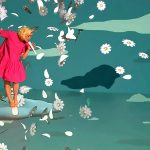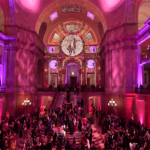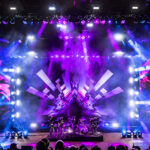With her daring multi-media show, The Neck is a Bridge to the Body, solo acoustic guitarist Kaki King explores the joys of oobleck, MIDI software and anthropomorphic surrealism.
You could be forgiven for believing that solo acoustic guitarist Kaki King’s multi-media show, The Neck is a Bridge to the Body, is the work of an artist with the neurological condition known as synesthesia.
Psychology Today identified synesthesia as occurring “when stimulation of one sensory or cognitive pathway (e.g., hearing) leads to automatic, involuntary experiences in a second sensory or cognitive pathway (e.g., vision).” This crossing or blending of the senses arises in individuals who associate certain colors and tastes with numeric values, musical notes, and/or letters of the alphabet.
Layered sensual stimulation is one way to describe how an audience experiences King’s psychedelic shows. Via the use of MIDI-based software, King’s musical technique is translated into a visual language. Nonstandard tuning, fingerpicking style and percussive tapping both invoke and evoke color, texture and cinematic narrative. It’s as if the musical and technological designs that create and operate the show have been fused, mimicking the complex cognitive processes known as synesthesia.
Since the early 2000s, King has steadily built a loyal following, and her handiwork can be heard on various soundtracks, including flicks August Rush and Into the Wild, for which she earned a Golden Globe nod in the Best Original Score category. King’s latest record, Kaki King Live at Berklee, is her second major release in just over two years, and she’s scheduled to perform live dates through March 2018. In addition, The Neck is a Bridge to the Body, which premiered in March 2014 at BRIC House Ballroom in Brooklyn, New York, continues to generate a buzz.
For all her individual accomplishments, King allows the technology that’s made her show a success to take center stage. Of even greater significance, King has receded into the very fabric of the production, becoming visually and virtually indistinguishable from its multi-media components. Let us explain.
King’s customized Ovation Adamas 1581-KK Signature acoustic guitar operates as much as a musical instrument as a video projection surface and controller. When King plucks the Ovation’s strings, perceived musical notes and experimental noises are interpreted by
MIDI-based audiovisual software, which triggers specific video files. This imagery is then projected onto an upstage screen and the guitar, which has been custom-painted white, frets and all.
Dressed in solid white, with matching sunglasses, shoes and a shock of bleached hair, King alternately absorbs and avoids the direct path of the projector’s beams via choreographed arm movements.
“I’ve become much more of a character in the show than I was in the [initial run of concerts],” King tells PLSN. “There’s a relationship between myself and the guitar that’s explored over the course of the evening. Clearly we’re close, but it’s very complicated as to who is in charge of who.”
“Kaki becomes an extension of the instrument, as opposed to the instrument being an extension of her,” says video director Max Bernstein. “It’s almost like a séance or a homage to the instrument.”

Pre-Production
Several personal and global events led to the initial development of the show. In 2008, King had Lasik eye surgery to treat her failing sight — a condition she’d had for most of her life. “I didn’t compute things as well visually as orally,” King says. “The second significant thing that happened during that time period, around the late 2000s, was people getting smart phones. It’s not just the ability to take photos but people displaying their lives via photos without any context. It was the right time mentally for my brain to speak in its own visual language.”
Both incidents were literal eye-openers and sparked King’s imagination. As such, King formulated ideas for The Neck is a Bridge to the Body and eventually produced three of the videos for the show, including content for “Oobleck,” so named for that mysterious cornstarch-and-water substance, and fan favorite “Carmine Street,” showcasing what King says were “sites in New York that weren’t iconic.” The third is a much more crazy. The guitar at some point in the show starts speaking to the audience, Charlie Brown-style; I’m using a wah-wah pedal to create that effect. I told this guitar’s life story, with subtitles. I wrote the script for that and produced that. I was out filming my guitar and moved it around to make it look like it was talking. It was all done in stop-motion. It was completely ridiculous, but funny.”
Show prep occurred at various studios prior to the project’s unveiling at BRIC. New York-based video design firm Glowing Pictures tapped both analog equipment and digital assets, such as Trapcode plug-ins, Java script generators, and GLSL shaders, during the initial content creation process for The Neck…
“We didn’t want to have a look that was readily associated with a given piece of software,” says media artist Benton C. Bainbridge, formerly of Glowing Pictures. “One thing I’d do is take Kaki’s initial demo tracks and play those tracks through a vintage oscilloscope, from the 1960s. I recorded the oscilloscope reacting to Kaki’s demo tracks and then fed those recordings through digital post-processing, using Red Giant plugins in After Effects to create [visuals] that would play across her guitar. I also put some footage Kaki shot in California through analog and optical image processing effects, including playing the footage on a well-used, well-loved CRT [cathode ray tube TV] that was part of the Beastie Boys’ To the 5 Boroughs tour. This was a super-high resolution black and white TV that had seen better days. It was water damaged and there was all this texture under the surface of the screen. It gave the footage this archival look.”
“Each one of the movie clips had a duration of about 30 seconds,” adds Glowing Pictures’ V. Owen Bush. “We had it set up so we could play 15 or 20 of these movies at a time, if she was playing very quickly.”
“Our mission was to make [the guitar] come alive,” says Bainbridge. “Not that the guitar was responding to the music, but more that the music was emanating from the guitar, and the projections would make the guitar come to life.”
With so much content, it begs the question: How much of what Glowing Pictures designed impacted King’s creative process? “I’ll say this: everything was in demo form at the time, but there were certain decisions I would not have made had [Glowing Pictures] not been showing me certain content,” says King. “Then, of course, [Glowing Pictures] would send me something visual, and I would say, ‘The video is now changing the music.’ So the music needed a different effect, or needed to be sped up or slowed down.”

MIDI Translations
Producing imagery for The Neck… was one thing. Controlling these images was another. King needed a reliable software configuration that could efficiently transform audio into video and bring order to the proceedings.
“All of my sounds are being run off of Logic and MainStage,” King says. “Max [Bernstein] is also running audio tracks that lock to video from his computer. My guitar goes into a DI [unit]. Out of the DI, I split my signal and run an XLR from that DI to [Bernstein], who’s getting a dry guitar signal. No effects, just the piezo pickup.”
“As Kaki mentioned, she has a DI box that splits her signal between the house and me,” Max Bernstein says. “I take that signal and send it into a couple different programs, one of which is called MIDI Guitar, a great application that transforms the analog audio signal into MIDI information based on frequency. Then, once that information is converted from pitch to MIDI notes, I can take that MIDI information and bus that into a program we use to run the show, called Resolume Arena. Resolume is predominately a video program, although there’s definitely some sonic capability within it, including some audio-reactive functions. Essentially every parameter within Resolume is MIDI-mappable.”
“Resolume accepts my levels and has various attributes,” says King. “The louder I play, the brighter the exposure. I scratch the surface of the guitar the brighter the image you see, but I can manipulate that. I’ll play a note and MIDI Guitar will read that, understand it, and trigger a clip. The latency is surprisingly low. I’ve learned, however, that to play a note and have a light bulb flash is difficult. Sound and vision are processed differently. But if you hear a reverb trail while a spiral is uncoiling, visually, then the reverb trail and spiral become connected.”
Isn’t That Spacial?
Once the software situation was sussed, gigging with the equipment necessary to stage the show became another major issue. Although King herself says, “You’d be surprised at the dives in which I’ve staged this show,” travel costs are still a major concern.
All guitar gear and hardware had to fit snugly inside backpacks, suitcases, and rolling bags. For one thing, since the Ovation remains stationary — it is a projection screen, after all — it requires a stabilizing guitar stand.
“I had to figure out how to weigh the stand down,” King says. “I wasn’t going to get on a plane with 20 pounds or more of sandbags. That’s absurd — and I have to pay for that. We’ve decided to carry around a water donut. We gaff tape the crap out of everything else. It’s almost become a spiritual discipline to pack as light as possible, because I’ve paid out the a** for so many years for it.”
Still, the gear — and theatrical space —
required for The Neck… is fairly minimal. Short-throw projectors are utilized for both the rear screen and the blanched guitar, which is positioned three feet or so downstage of King. A web cam is placed right above the downstage projector’s lens. The Spacial Scanner utility app within MadMapper software receives information from the camera and measures the distance from the guitar to the projector so that a video mask can be designed.
“MadMapper software throws a bunch of two-dimensional black and white patterns on the guitar,” explains Bernstein. “Based on the live feed of the camera, it starts to do all the number crunching of measuring the difference between the two-dimensional version of the black and white images and what is happening to them in the three-dimensional space. Once we have that disparity, it allows us to create a spatial scan of the object.”
Aided by the proper software, the entire process of measuring and mapping the acoustic guitar takes about an hour or so. “We wanted the audience to be very close to Kaki, so we didn’t want a projection setup that required her to be very far away on a stage,” says Glowing Pictures’ Bush. “Although there could be a slightly different distance from the guitar to the projector, MadMapper allowed us to map the guitar on the fly at different venues.”

Improv
Although largely scripted, The Neck… contains moments of genuine surprise. “We did a gig in a cave in Cappadocia, Turkey,” says Bernstein. “One of the big things in that town is hot-air ballooning over the city. You have this ancient city made of rock bluffs, basically, and we shot a bunch of footage from the sky. Occasionally, I’ll use some of that content and [King] usually enjoys that surprise.”
“There’s a performance element that [Max Bernstein] and I improv upon every night,” says King. “We are both performing and improvising.”
“In moments of improvisation, it becomes a challenge, but also a game between the two of us in which we are pushing and pulling and influencing one another,” adds Bernstein.
This level of comfort is something that has been earned, not bestowed. King admits that the show has been tweaked and become stronger, smoother and more theatrical over the last couple of years. “It’s the tiny, small, subtle but fixable elements that get tightened up, show after show, that make a big difference from one year to another,” says King.


